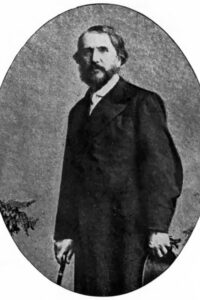
Wylder’s Hand
It was late in the autumn, and I was skimming through a rich English county in a postchaise, among tall hedgerows gilded, like all the landscape, with the slanting beams of sunset. The road makes a long and easy descent into the little town of Gylingden, and down this, we were going at an exhilarating pace; the jingle of the vehicle sounded like sledge-bells in my ears, and its swaying and jerking were pleasant and life-like. I fancy I was in one of those moods which, under similar circumstances, I sometimes experience still—a semi-narcotic excitement, silent but delightful.
An undulating landscape, with a homely farmstead here and there and plenty of old English timber scattered grandly over it, extended mistily to my right; on the left, the road is overtopped by masses of noble forest. The old park of Brandon lies there, more than four miles from end to end. These masses of solemn and discoloured verdure, the faint but splendid lights, and long filmy shadows, the slopes and hollows—my eyes wandered over them all with that strange sense of unreality and that mingling of sweet and bitter fancy, with which we revisit a scene familiar in very remote and early childhood, and which has haunted a long interval of maturity and absence, like a romantic reverie.
As I looked through the chaise windows, every moment presented some group, outline, or homely object for years forgotten. Now, with a strange surprise, how vividly remembered and affectionately greeted! We drove by the small old house at the left, with its double roof and pretty grass garden, and trim yews and modern lilacs and laburnums, backed by the grand timber of the park. It was the parsonage, and old bachelor Doctor Crewe, the rector, in my nonage, still stood, in memory, at the door, in his black shorts and gaiters, with his hands in his pockets, and a puckered smile on his rugged, ruddy countenance, as I approached. I believe he smiled little on others but always kindly upon me. This general liking for children and instinct to smile at them is one source of the delightful illusions that make the remembrance of early days so like a dream of Paradise and give us, at starting, such false notions of our value.
As I whirled by, a little fair-haired child was playing on the ground before the steps. The old rector had long passed away; the shorts, gaiters, and smile—a phantom; and nature, who had gathered in the past, was providing for the future.
Read or download Book
Joseph Sheridan Le Fanu
Joseph Thomas Sheridan Le Fanu (28 August 1814 – 7 February 1873) was an Irish writer of Gothic tales, mystery novels, and horror fiction.
Biography.
He was a leading ghost story writer of his time and central to the genre’s development in the Victorian era. M. R. James described Le Fanu as “absolutely in the first rank as a writer of ghost stories.” Three of his best-known works are the locked-room mystery Uncle Silas, the lesbian vampire novella Carmilla, and the historical novel The House by the Churchyard.
Work
Le Fanu worked in many genres but remains best known for his horror fiction. He was a meticulous craftsman and frequently reworked plots and ideas from his earlier writing in subsequent pieces. Many of his novels, for example, are expansions and refinements of earlier short stories. He specialized in tone and effect rather than “shock horror” and liked to leave important details unexplained and mysterious. He avoided overt supernatural effects: the paranormal is strongly implied in most of his significant works, but a “natural” explanation is also possible. The demonic monkey in “Green Tea” could be a delusion of the story’s protagonist, who is the only person to see it; in “The Familiar”, Captain Barton’s death seems to be supernatural but is not witnessed, and the ghostly owl may be a real bird. This technique influenced later horror artists, both in print and on film (see, for example, the film producer Val Lewton’s principle of “indirect horror”). Though other writers have since chosen less subtle techniques, Le Fanu’s finest tales, such as the vampire novella Carmilla and the short story “Schalken the Painter”, remain some of the most powerful in the genre. He had an enormous influence on one of the 20th century’s most influential ghost story writers, M. R. James, and although his work fell out of favour in the early part of the 20th century, towards the end of the century, interest in his work increased and remains comparatively strong.
The Purcell Papers
His earliest twelve short stories, written between 1838 and 1840, are the literary remains of an 18th-century Catholic priest called Father Purcell. They were published in the Dublin University Magazine and were later collected as The Purcell Papers (1880). They are primarily set in Ireland and include some classic stories of gothic horror, with gloomy castles, supernatural visitations from beyond the grave, madness, and suicide.






